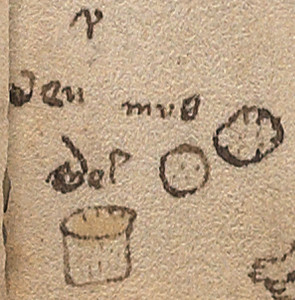I’ve already written about the text next to the “aching tummy” figure at the base of folio 66r in a couple of blogs but perhaps it’s time to post some of the background information that influenced my ideas about what it might say.
Ven Muß Mel
I should start by saying, I’m pretty sure there is a letter “m” in “mel” that has been overwritten with a couple of heavier strokes so that the changed letter almost resembles a “g”. Since the interpretation of “mel” and “gel” are very different, this blog will concentrate on the original word “mel” and leave “gel” for a separate blog.
Note that it was very common for a single “s” to be written as “ß” in the middle ages, if it was at the end of a word. It was not always intended as a ligature for double ess.

I’ve already described some possible interpretations for individual parts of this phrase. To recap, in Anglo-Saxon “ven/wen” refers to a swelling or tumor, which may or may not apply to how it is used here, but should be considered as a possibility because the mysterious letter above it resembles an Anglo-Saxon letter form.
In German, muß typically means must/should but can also be “mouse” in Nordic areas. The word “mel” sometimes means honey (more often spelled melle, but sometimes also mell or mel), a very common ingredient in medieval remedies. Mel can also mean flour, and it too is a common ingredient.
All these interpretations have been mentioned in my previous blogs, but I thought I would take a moment to fill in some of the background information that influenced my perception of the text.
This is just one possibility, but if we consider “muß mel” as belonging together, we get a phrase (or compound word) that can be traced back to the middle ages.
Müsmehl is ground grain that was distinguished from bread flower by its color and texture. It was known as musmel/müsmel in the middle ages, and corresponds to later spellings of müsmehl and Muasmähl (note that corn meal was sometimes substituted for the original grains after the conquest of the Americas). This ground grain was used for porridge and a granola-like mixture, similar to the grains in muesli/müsli (note the similarity in the words).
Historical Confirmation of Terminology
In the Hermann Miles Chronik notation for anno 1529, there is a list of prices for basic foodstuffs. It tells mentions a quarter of “korn” (grain) and a “fierlig” of müsmel at 18 d.
Schillings, florins, and ducats were common currencies at the time, but I’m not sure what the currency unit “d” represents. Fiertel is a quarter, but fierlig appears to be a larger quantity, given that a fierlig of müsmel was almost four times costlier than a pound of “flaisch” (meat). Note that the definition of a “pound” varied from region to region.
In Württembergische Geschichtsquellen, published in 1905 in Swabia, the distinction between “schön mel” and “müsmel” is noted. In English, schön mel generally refers to fine flour—flour for breads and pastries.
Thus, the term is documented in print at least by the 16th century and may have existed in oral history for some time prior.
Summary
I’ve already mentioned that the handwriting on 66r next to the prone figure appears to be the same hand that wrote the marginalia on 116v. What is particularly interesting about the term “musmel/ mus mel” is that it was not widespread. In this form, it was mainly used in an area that is geographically consistent with some of the idiosyncracies in the spelling/grammar of the marginalia on the last page. For example, in Schwabia and the Alsace, “p” was often substituted for “b” (which would support an interpretation of “pox” as goat) and “a” for “e”, and letters were frequently dropped from words—characteristics one sees in the Hermann Miles Chronik and that are expressed or hinted at on 116v.
Although I have spent several years trying to systematically track down the homeland of the marginalia writer, and have a great deal of paleographic data, I haven’t yet committed to a specific region. Gothic cursive was written everywhere from Scotland to Naples, and France to Bohemia in the 15th century, and the marginalia writer’s hand (which is a mixture of cursive and book forms) does not give away a specific location. However, the combination of the handwriting style and the spelling and grammar suggests that the marginalia author may have learned to write Latin letter forms in the Alsace or Swabia.
If the marginalia on 66r is intended to be “muß mel” in the sense of ground grains/flour, and if the scribe is the same person who penned 116v, then it strengthens the evidence for the Voynich manuscript having passed through the hands of someone familiar with linguistic conventions of a fairly specific region.
J.K. Petersen
© Copyright 2017 J.K. Petersen, All Rights Reserved
Postscript October 2018: At first I thought that the handwriting on 116v and 17r and 66r were all in the same handwriting. They are a similar style. But after more study and collecting many more thousands of medieval handwriting samples, I am no longer sure. I still believe 116v and 17r are in the same handwriting, but I now have doubts about the short note on 66v for a number of reasons.



d is denarius, German Pfennig or English penny. ₤, sh and p , pound shilling and pence in England until the seventies
A fierlig (= Vierling) is a quarter of any measuring unit
Thank you, Helmut, for that information.
That leaves me wondering whether the grain was sold in sacks (the big ones), if a quarter of grain was more expensive than a pound of meat.
I think grain was sold (and transported) loose at the time, I guess the measurement is “Scheffel”, “Der vierte Teil des Scheffels wurde Fehrt, Fehrd oder Viert/Viertel/Vierfaß genannt” – https://de.wikipedia.org/wiki/Scheffel_(Ma%C3%9Feinheit)